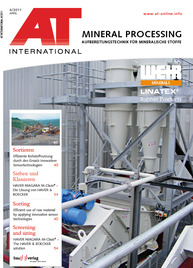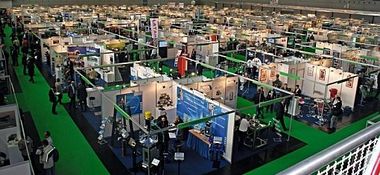New conference on bulk solids at easyFairs Schüttgut
Schüttgut 2011, Dortmund/Germany (18.-19.05.2011)
The easyFairs Schüttgut in Dortmund is now acknowledged as a leading trade show for the bulk solids industry. The concept of a trade fair that brings together suppliers and consumers in high-density areas, close to the professionals in the sector, has worked out well. The trade fairs focus on business needs and also provide information and options for professional learning. All this takes place under one roof so that exhibitors and visitors get unrivalled value than for the time they invest. The suppliers present themselves and their products under the “same competitive conditions”. Consequently, the visitors get a balanced impression that is based on the products on show rather than on the size of the stand.
In line with this easyFairs idea, a conference module was developed, which is another of the easyFairs benefits. Time saving and catering for individual needs, the Schüttgut easy-update-conference helps visitors find the right answers to current questions in the bulk solids industry. Depending on the visitors’ interests, they can book the appropriate lecture in advance on the internet. During the conference, visitors can talk to qualified speakers from companies and universities in order to broaden and update their knowledge. For the Schüttgut easy-update-conference in Dortmund on 18.05.2011, the independent experts Prof. Dr.-Ing. Dietmar Schulze from the Ostfalia University of Applied Sciences, Braunschweig/Wolfenbüttel, and Dipl.-Ing. Harald Heinrici, (Fig.) Schwedes + Schulze Schüttguttechnik, Wolfenbüttel, have taken over the responsibility for the conference content and direction. Spread over the day of the trade fair, six lecture units have been scheduled. These modules can be booked on the internet at the website http://www.easyupcon.com. As places are limited, internet booking guarantees visitors assured participation with a price advantage. Providing spaces are available, last-minute attendees can cash in a visitor voucher at the conference itself. The following lecture units can be chosen.
Prof. Dr.-Ing. André Katterfeld explains the basics of the Discrete Element Method (DEM)-based computer simulations used increasingly for the analysis of particle processes and discusses how realistic these simulations are. In addition, with reference to various case studies, he describes how DEM is used to simulate the material stream, dust generation and comminution processes.
Silos hold a special place among work equipment. Generally they are structures, but on the other hand they are also machines in accordance with the machine directive. This means that they must satisfy certain basic requirements with regard to structural stability, EC conformity (Declaration of Conformity, operating instructions) and tests. Often, problems occur during the operation of silos as a result of the behaviour of the bulk solids and also caused wear or faults in the structure or the technical equipment installed. Operatives often climb or travel into the silo to carry out repairs or eliminate material bridges or clogging. Particularly during these activities, accidents frequently occur with serious injuries or fatal consequences, because those responsible are not aware of existing dangers or loads or neglect these and do not give adequate consideration to available technical, organizational and protective measures for operative health and safety. Work in silos is dangerous work and should not be performed alone.
Starting from accidents in the building materials sector, Dipl.-Ing. Jürgen Pester discusses the key importance of hazard assessment for risk reduction from silo erection to troubleshooting. Selected rules and regulations, which should be complied with, are explained and derived measures as well as possible support and aids available from the BG RCI (German Accident Prevention & Insurance Association for the Raw Materials and Chemicals Industry) are described.
The knowledge of the flow properties of a bulk solid is necessary to design silos and other bulk solids equipment such that no flow problems (flow interruptions, segregation, irregular flow, flooding,...) occur. In addition, details for the assessment of product flowability are increasingly required, for example as obtained in comparative measurements (e.g. information on the impact of flow aids or other additives on the flow behaviour), product monitoring and quality assurance. Prof. Dr.-Ing. Dietmar Schulze ex-plains what effects determine the flow properties, how flowability can be defined and how flow properties can be usefully measured.
During storage and flow of bulk solids in improperly designed hoppers, silos, etc., problems frequently occur. The bulk solids flow is too slow, fluctuates widely or stops completely, the flowing product shows signs of segregation or the silo structure is subject to excessive stresses. These problems can be avoided with a design based on bulk solids mechanics aspects. Here the hopper or silo form and, if necessary, the discharge equipment is adapted to the properties of the product to be stored. After a description of the problems that can occur in poorly designed bulk solids containers, Prof. Dr.-Ing. Dietmar Schulze describes ground rules for the design of hoppers and silos.
The reliable pneumatic emptying of bulk tankers often fails on account of the improper planning of the conveying equipment, coupled with insufficient consideration of the products to be unloaded and their specific properties. Dipl.-Ing. Klaus Schneider explains the most important basic elements for a successful operation of tanker trucks and rail waggon unloading and, with reference to examples, details the correct procedure for planning and designing unloading equipment. A checklist for this procedure answers important questions concerning pipeline diameter, maximum conveying rate/distance, the use of additional blowers, pipeline planning, shortening unloading times, cooling discharge air, optimal operating conditions, etc.
With process engineering silo design, it is possible to design a silo to avoid operating faults. Basis for the design are the determined flow properties of the bulk solid to be stored in the silo. In the design of the silo, the requirements resulting from the application (storage volume, building height, quality requirements, and costs) have to be taken into account – without neglecting the results of the process-engineering-based silo design. With reference to three case studies, Dipl.-Ing. Harald Heinrici explains how to design a silo to reduce abrasion or segregation and how to select hopper shape and material to optimize costs with allowance for the flow properties of the material to be handled.







